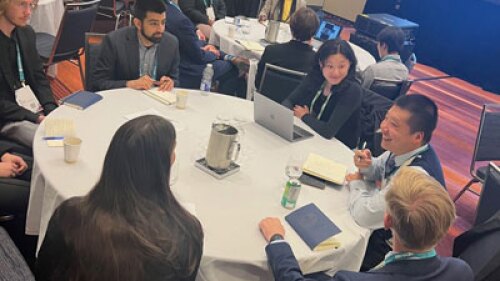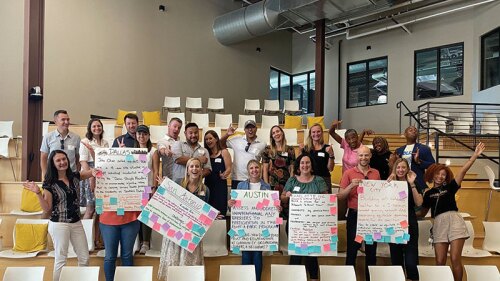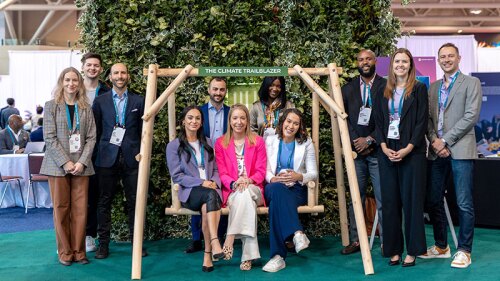Minnesota’s urban and rural mayors are putting partisan politics aside and joining forces to find common ground on issues that include housing, transportation, and the workforce in an effort led by the ULI district council for the Twin Cities region.
The focus of the Minnesota Mayors Together in initiative is to change the negative narrative of “urban vs. rural,” working together as a cohesive region with shared values rather than divided by politics and individual interests, says Caren Dewar, executive director of ULI Minnesota. “The goal of this is to establish trust that will lead to shared action,” she says.
MN Mayors Together is an offshoot of the state’s nationally recognized Regional Council of Mayors (RCM), which was formed in 2004 by ULI Minnesota as a nonpartisan platform that brings about 55 mayors from the Minneapolis-St. Paul metro together as a collaborative group. RCM gathers monthly to build relationships, network, learn, collaborate and take action on issues related to building healthy communities.
The idea for MN Mayors Together originated in an RCM meeting nearly two years ago when members voiced frustrations about the pattern of gridlock in the state legislature. One of the factors that the group felt contributed to that gridlock was that the idea of an urban-rural divide was being used to foster various political agendas. “It was a narrative that we really felt was holding us back as an entire state, and much of it was based on inaccuracies,” says Molly Cummings, who co-chaired the Regional Council of Mayors as the then-mayor of Hopkins. Cummings was recently appointed to the Metropolitan Council, a governing body responsible for regional planning in the seven-county metro area.
That discussion served as a catalyst for creating a separate initiative where metro mayors would travel to different regions of the state to open up dialog and build a bridge between urban and rural interests. ULI MN has been supporting the RCM initiative for the past 16 years, and the association also provides administrative and leadership support to MN Mayors Together.
Discovering Common Ground
Since it launched in 2017, the group has held three collaborative meetings in Bemidji, Duluth and Willmar with a fourth meeting set for Owatonna in March. The events typically include small group gatherings with between 15 to 20 mayors from both the metro and the region where that meeting is being hosted attending. Meetings focus on opening lines of communication, creating new relationships and learning about the strengths and challenges facing those outstate regions.
Views vary on the extent of the urban-rural divide. “There are some who believe it is quite a chasm between the metro and rural who continue to compete with each other for different sources,” says Marv Calvin, mayor of the city Willmar. Calvin has been an active participant ever since the city of Willmar hosted the group of mayors in December. “I am one who believes that there is a disparity between the metro and greater or rural Minnesota, but one of the things that I found out was that a lot of the concerns they have in the metro are very similar to what we have in rural,” he says.
The metro mayors that have committed to doing this also have a changed perspective, because they are learning how vulnerable it is in greater Minnesota, adds Dewar. The precarious nature of rural economies is more pronounced amid the broader trend of urbanization, and many states across the country face similar rural-urban divides.
Urban areas tend to have a more diverse economy, more employers, bigger labor pool, bigger tax base, better transportation infrastructure and more housing options. Meanwhile, rural areas are more dependent on their existing business base and are hit hard if a major employer downsizes or the local Walmart store closes. “This has led to a deeper understanding of the common issues of urban and rural and a deeper understanding of the challenges each face,” says Dewar.
Aligning Interests
One of the direct benefits of the initiative is simply opening up discussion about common issues and sharing experiences. “Being a mayor is not an easy job, and a lot of times you think you’re alone, but this group of individuals sitting down in a smaller, more intimate group really gave me the opportunity to share my thoughts, get some feedback and then make my community better and stronger,” says Calvin.
For example, the city of Willmar is exploring ways to change one of its funding mechanisms that would increase revenue to pay for street improvements. The topic came up at a meeting and it turned out that one of the metro mayors had made that same change about three years ago. The metro mayor was able to provide specific recommendations of what worked, and more importantly, how his community reacted to the new method of paying for streets, notes Calvin. “Without that conversation, I would have explored that on my own and I would not have been as successful because I would have stubbed my toe similar to how he stubbed his,” he says.
The group also hopes that its collaboration will help to spur progress in the legislature on common issues. The three main priorities in the near are improving housing for all, transportation and access to daycare. Access to affordable daycare is a problem throughout the state that creates a variety of ripple effects, including a family’s ability to afford housing and labor availability. Shortage of workers is a common problem throughout the state with unemployment levels that are hovering at 2.8 percent according to the Bureau of Labor Statistics.
MN Mayors Together recently received a Bush Foundation grant to help the group develop a sustainable model and determine shared priorities. The RCM does not advocate for any particular issue or legislation, notes Cummings. “However, we can certainly make our voices heard on these issues,” she says. Joining urban and rural mayors together to meet with legislators on a particular issue creates a much louder voice, she adds.
“Going forward, I think by combing our voices we can bring more collective pressure to bear, and hopefully get the state to step up on helping to fund some of the solutions like affordable housing, transportation and transit,” says Cummings. “I think when we unite, we present a much stronger front and perhaps have a greater chance of being heard.”




